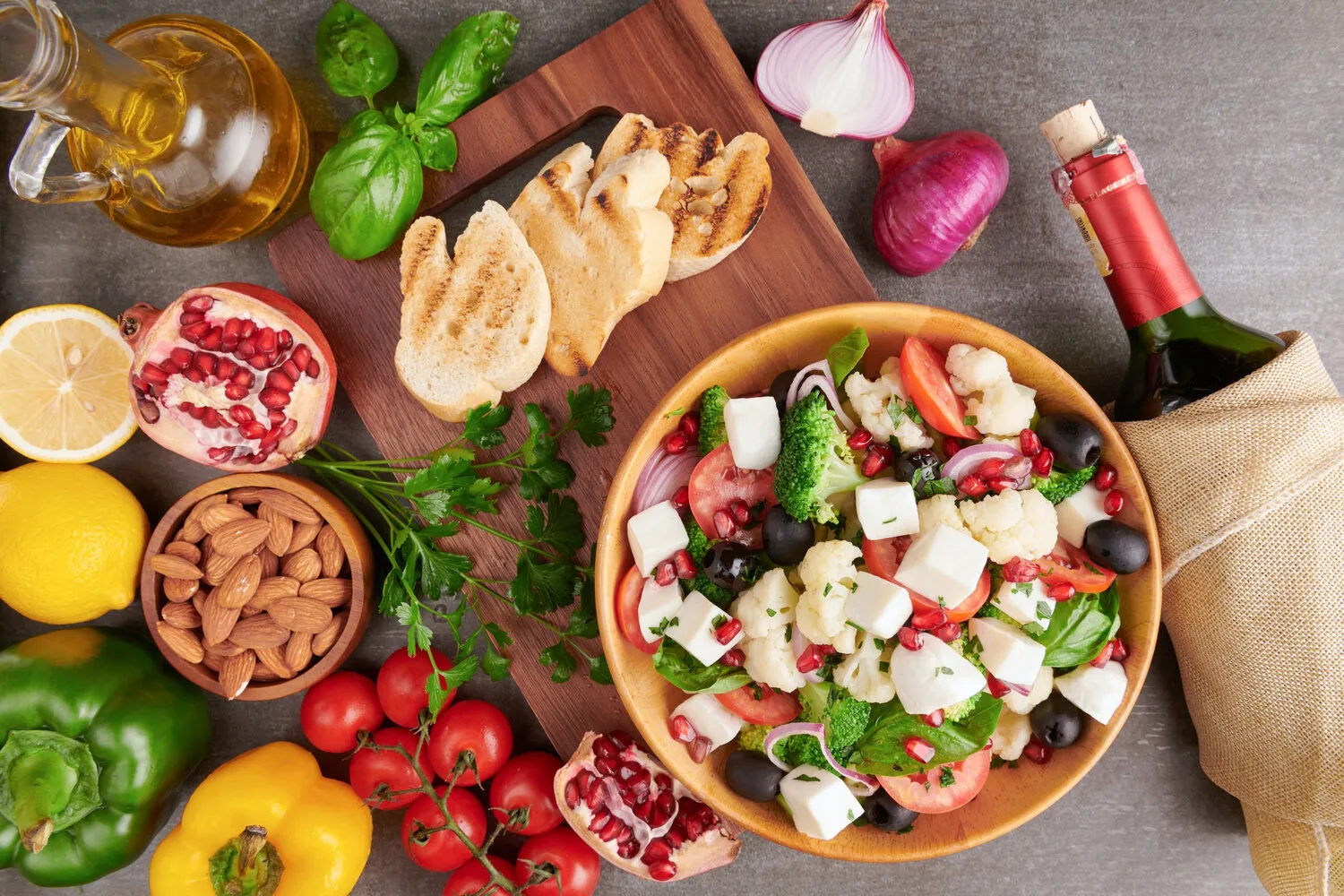There can be your advertisement
300x150
Mediterranean Diet in Russian Realities: What to Replace and How to Adapt
Remember: the most beneficial diet is one you can follow for a long time with pleasure
The Mediterranean diet is called the healthiest in the world. But when you start studying recipes, it turns out that half of the products in stores cost as much as an airplane wing, and the other half isn't sold at all. Do we have to give up on the dream of healthy eating? Let's see how to adapt Mediterranean principles to Russian products and budget.
 Photo from freepik.comMain points of the article:
Photo from freepik.comMain points of the article:- The core of the Mediterranean diet is its eating principles, not specific products;
- Russian analogs of expensive Mediterranean products often aren't inferior in benefits;
- Seasonality and product availability matter more than strict adherence to original recipes;
- Adapting the diet to climate and eating traditions increases chances of success;
- A budget-friendly version of the Mediterranean diet can be more effective than an expensive original.
What is the Mediterranean Diet Really
The Mediterranean diet is not a set of specific products, but a philosophy of eating for residents of Greece, Italy, and Spain in the middle of the 20th century. Key principles:
- Plenty of vegetables and fruits — the base of every meal;
- Fiber-rich grains instead of refined ones;
- Fish and seafood 2-3 times a week;
- Olive oil as the main fat source;
- Nuts and seeds daily in small amounts;
- Red meat no more than 1-2 times a week;
- Dairy products in moderate amounts;
- Red wine in small quantities with dinner.
If you understand the essence rather than clinging to specific products, adaptation becomes a simple task.
The Most Expensive Components and Their Substitutes
- Olive oil → flaxseed, rapeseed, unrefined sunflower:
Extra virgin olive oil costs 500 rubles per liter. Flaxseed oil contains more beneficial omega-3 fatty acids and costs twice as little. Unrefined sunflower oil is a budget-friendly alternative for frying.
Main rule: use different oils. Flaxseed oil for salads, rapeseed for frying, olive oil when you want authentic taste.
- Sea fish → freshwater fish, canned fish:
Fresh tuna and dorada cost 2000 rubles per kilogram, not everyone can afford them. But pike perch, pike, and carp contain just as much protein. Canned sardines, mackerel, and anchovies are excellent sources of omega-3 for a few kopecks.
Substitution principle: any fish is better than no fish in your diet.
- Artichokes, asparagus, arugula → cabbage, spinach, leafy greens:
Exotic vegetables for 800 rubles per kilogram can be replaced with affordable alternatives. White cabbage contains as much vitamin C as an artichoke. Spinach is not inferior to arugula in iron and folate content.
- Cedar nuts → walnuts, seeds:
Cedar nuts cost 3000 rubles per kilogram. Walnuts contain more omega-3 and are five times cheaper. Sunflower and pumpkin seeds are budget-friendly alternatives rich in vitamin E.
Adapting to Russian Climate
- The Mediterranean diet was created for a warm climate where fresh vegetables and fruits are available year-round. In Russian conditions, adjustments are needed:
- More calorie-dense products in winter. In cold weather, the body spends more energy on heating up. Increase nuts, seeds, and fatty fish portions.
- Active use of freezing. Frozen vegetables and berries are more beneficial than imported “fresh” ones shipped halfway across the world.
- Seasonality is the main principle. Summer — fresh vegetables and greens, autumn — apples and pumpkins, winter — fermented cabbage and root vegetables.
Russian Superfoods Instead of Mediterranean
- Fermented cabbage → olives:
Fermented cabbage contains probiotics and vitamin C, supporting gut health just as well as expensive olives.
- Cranberries → grapes:
Northern berries contain more antioxidants than Mediterranean grapes and store well all winter.
- Buckwheat → bulgur:
Buckwheat porridge is a traditional high-protein, mineral-rich product. It surpasses many Mediterranean grains in nutritional value.
- Cottage cheese → Greek yogurt:
Regular 5% fat cottage cheese contains more protein than expensive Greek yogurt and costs three times less.
Example Russian Mediterranean Meal Plan
- Breakfast: Oatmeal with apple and walnuts, green tea;
- Lunch: Soup of fresh cabbage with carrots and onions, a slice of black bread, cucumber salad with flaxseed oil;
- Snack: Cottage cheese with frozen berries;
- Dinner: Baked mackerel with stewed zucchini, herbal tea.
The cost of such a day is about 300 rubles. An authentic Mediterranean meal plan would cost 1500-2000 rubles.
Cooking Mediterranean Style with Russian Ingredients
- Minimal processing principle. Slightly stew vegetables or eat them raw, bake or steam fish instead of frying in oil.
- Plenty of greens and spices. Dill, parsley, basil, garlic — greenery is just as good as Mediterranean. Spices improve digestion and add flavor to simple dishes.
- Simplicity of preparation. Complex sauces and multi-component dishes are not part of the Mediterranean diet. Simpler is better.
What You Don't Need to Buy
- Expensive superfoods. Chia seeds, goji berries, spirulina — marketing tricks. Russian products are just as beneficial.
- Special Mediterranean products. “Mediterranean” salt, oil, spices in attractive packaging — overpaying for a brand.
- Exotic fruits all year round. Avocados for 200 rubles each in winter — questionable spending. Better apples and pears from local orchards.
Psychological Aspects of Adaptation
A strict copy of the Mediterranean diet may cause stress due to unfamiliar products and high cost. A modified version works better because:
- Familiar products don't evoke rejection;
- Affordable cost removes financial pressure;
- Tradition consideration makes the diet a natural part of life;
- Seasonality supports dietary variety.
Mistakes in Adaptation
- Replacing all fats with sunflower oil. Variety in fats is important — use different oils and add nuts.
- Abstaining from fish due to cost. Canned fish, freshwater fish, fish patties — any fish is better than its absence.
- Ignoring seasonality. Tomatoes for 400 rubles per kilogram in winter — a bad idea. Better fermented cabbage and carrots.
- Too literal following of recommendations. If you don't like olives — don’t force yourself. Find what's both enjoyable and beneficial.
Economic Benefits of Adaptation
A Russian version of the Mediterranean diet can cost 60-70% less than the original while preserving all beneficial properties.
Monthly savings for a family of three: 15,000–20,000 rubles. At the same time, food quality does not decrease and sometimes even improves due to fresher and seasonal ingredients.
Key Principle of Successful Adaptation
The Mediterranean diet is a lifestyle, not strict rules. It's important to understand the essence: more plant-based foods, less processed products, moderation in all things, and pleasure from eating.
Russian ingredients perfectly fit these principles. The key is not to blindly copy, but creatively adapt to our conditions, budget, and tastes.
And remember: the most beneficial diet is one you can follow for a long time with pleasure. A Russian adaptation of the Mediterranean diet can be exactly that — accessible, delicious, and truly healthy.
Photo cover from freepik.com
More articles:
 Color Map of the House: How to Use 2025 Trends in Each Room
Color Map of the House: How to Use 2025 Trends in Each Room 10 Dining Tables: Trendy Models for Your Interior
10 Dining Tables: Trendy Models for Your Interior Myths or Truth: Secrets of the Strangest Houses in Moscow
Myths or Truth: Secrets of the Strangest Houses in Moscow Interior Design Trends 2025–2026: Key Directions
Interior Design Trends 2025–2026: Key Directions Uma Thurman in the New 'Dexter': Secrets of the Role and What the Actress Revealed About Filming
Uma Thurman in the New 'Dexter': Secrets of the Role and What the Actress Revealed About Filming Electricians Scammers: 5 Schemes That Will Cost Hundreds of Thousands
Electricians Scammers: 5 Schemes That Will Cost Hundreds of Thousands China Town: Why the Main Trading Quarter Was Named After Celestial Kingdom
China Town: Why the Main Trading Quarter Was Named After Celestial Kingdom Where to Place a Bed in a Small Studio: 5 Best Solutions
Where to Place a Bed in a Small Studio: 5 Best Solutions